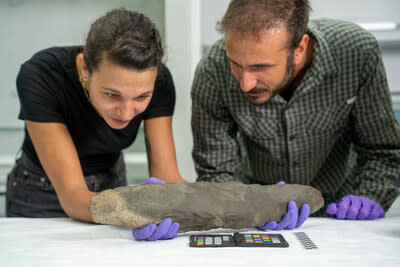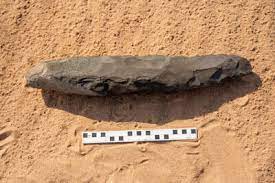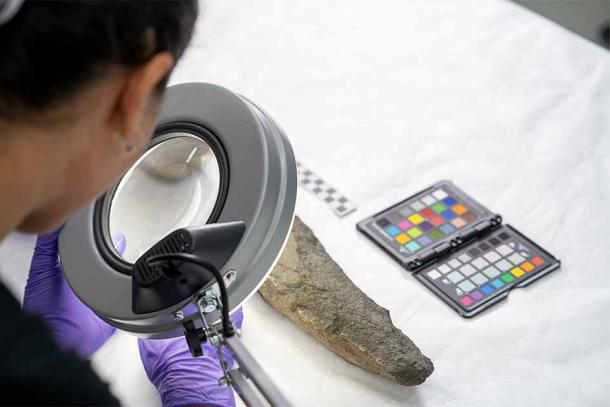
In the deserts of Saudi Arabia, the breathtaking oasis of AlUla has nourished and sustained human occupation for thousands of years. With wealth generated by the incense trade and agriculture, powerful ancient kingdoms grew and flourished in the valley: commerce, art, languages, and ideas have long ebbed and flowed among its date palms.
The Royal Commission for AlUla’s research teams in northwestern Saudi Arabia, continue to unravel ancient mysteries, discovering what is believed to be the largest stone “hand axe” found anywhere in the world.
The team has already been successful in discovering archaeological artefacts showing this forbidding land supported a vibrant community from the early Islamic period, and now the discovery of this rare and unique object promises to write a new chapter of human history in Arabia and beyond.
 Made of fine-grained basalt, the stone tool measures 51.3cm long and has been worked on both sides to produce a robust tool with useable cutting or chopping edges. At this stage a function can only be guessed, but despite its size the tool fits comfortably in two hands.
Made of fine-grained basalt, the stone tool measures 51.3cm long and has been worked on both sides to produce a robust tool with useable cutting or chopping edges. At this stage a function can only be guessed, but despite its size the tool fits comfortably in two hands.
While the greatest numbers of Homo sapiens moved into the lands of modern-day Saudi Arabia within the past 80,000 years, they were not the original migrants. The latest research suggests humans left Africa in five different waves starting 400,000 years ago, which means the stone toolmaking culture might have established a presence on the Arabian Peninsula tens of thousands of years—or even longer—before the stone axes were actually manufactured.
Archaeologists are unable to say much about these ancient toolmakers, beyond acknowledging their ability to make cutting and chopping axes that were ideally suited for people pursuing a hunting and gathering lifestyle.
 Nevertheless, the excavations around Qurh are slated to continue for a quite some time, as archaeologists have currently opened up 11 different areas for exploration. This means that it is possible—if not likely—that other extremely ancient artifacts will be found at some point, which would help experts learn more about how the Arabian Peninsula’s oldest human settlers lived and survived.
Nevertheless, the excavations around Qurh are slated to continue for a quite some time, as archaeologists have currently opened up 11 different areas for exploration. This means that it is possible—if not likely—that other extremely ancient artifacts will be found at some point, which would help experts learn more about how the Arabian Peninsula’s oldest human settlers lived and survived.
Dr. Ömer Aksoy, project leader, said: “This amazing stone tool is more than half a meter long (length: 51.3 cm, width: 9.5 cm, thickness: 5.7 cm) and is the largest example of a series of stone tools discovered at this site. When searching for comparisons around the world, no hand ax of the same size was found. This could make it one of the largest hand axes ever discovered act.”
Credit: The Royal Commission for AlUla
Photo Credits: The Royal Commission for AlUla
